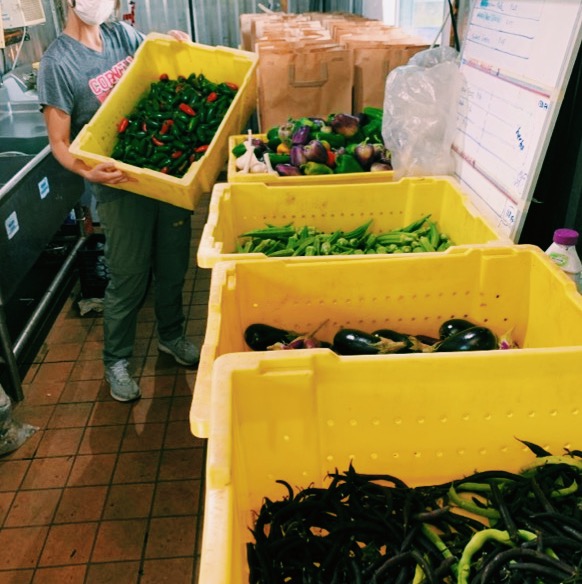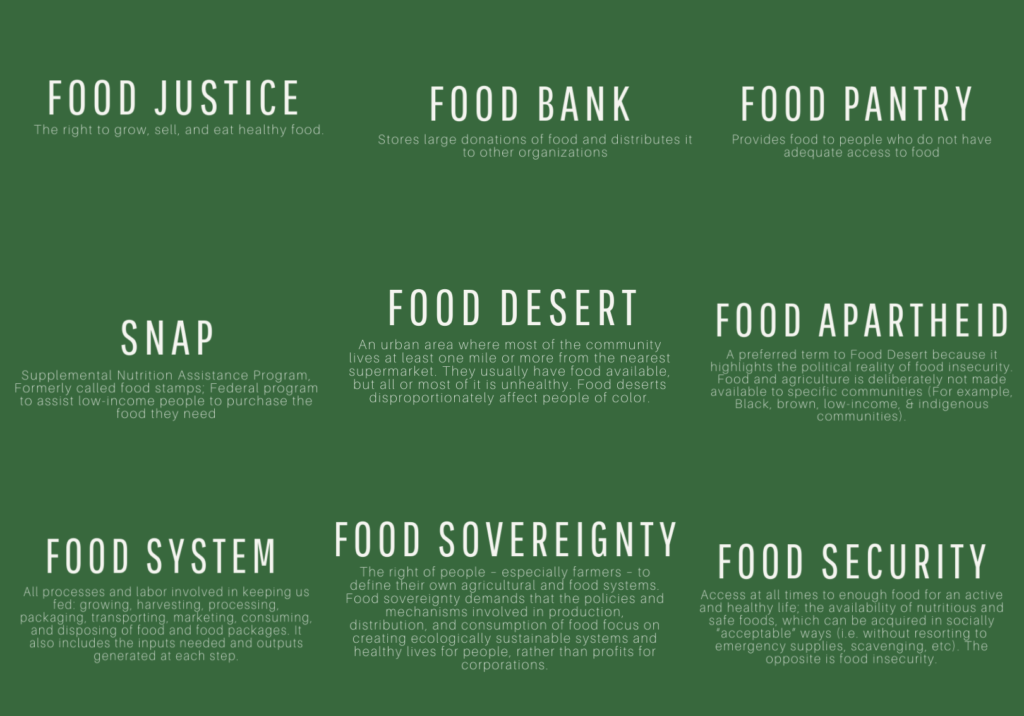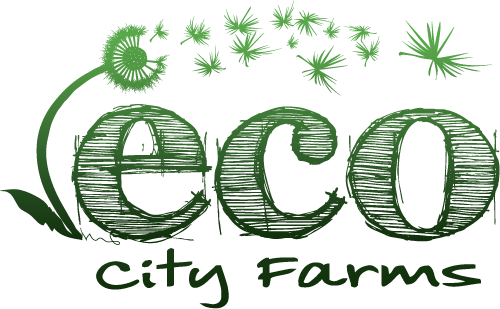Food Day 2021 Food Justice
Challenge Takeaways: understand the definition of food justice, how we can make access to fresh and nutritious food more equitable, what community/local resources are available

One of the most consistent things we do throughout our life is eat. Beyond satisfying hunger, when we eat healthy and nutritious food, our bodies are replenished with the energy we need to function at our highest capacity. However, many individuals lack the resources to have a healthy diet, or even steady access to food. The Food Justice Movement seeks to ensure universal access to healthy, affordable, and culturally-appropriate food for all, while the safety and wellbeing of those involved in the food production process is also of importance. Examining the structural roots of our current food system can help to understand disparities in food access, particularly in low income communities or communities of color. For more information on the history of this grassroots movement and its intersectionality with race and class, social justice and sustainability, check out this resource from the Aspen Institute.
Terms to be familiar with

Source: Boston University Community Service Center
A 2015 assessment of access to healthy food in Prince George’s County found that the county has higher than average rates of diet-related chronic diseases. Residents may have difficulty accessing quality, nutritious, affordable food within a reasonable distance from where they live. Although Maryland is the wealthiest state in the country, food insecurity is still prevalent as one in seven people in Prince George’s county are food insecure, and participation in the federal food assistance programs is on the rise. A survey of participants in federal nutrition assistance programs revealed that more than half of respondents said they only buy fruit and vegetables once a month, and one third of respondents are not able to feed their children enough nutritious food all or some of the time.
“Food retail stores are concentrated along major roads but prepared food outlets that carry foods high in fat, salt, and sugar are scattered, making them easier to access than healthy food.”
The quality of local stores may be a larger barrier to food access than physical access to food, while many residents who have access to a car travel elsewhere to find food of better quality and more variety. Zoning regulations also come into play, separating the uses of commercial and residential areas, which leaves most residential neighborhoods without supermarkets.
Currently, around 55% of the world’s population resides in cities, and this number is expected to grow to 68% by 2050. Furthermore, More than 3 billion people (almost 40% of the world’s population) cannot afford a healthy diet. If this trend continues, more and more people will be further isolated from sources of fresh and nutritious food. Thus, it is highly important for urban communities to be equipped with the knowledge, space and resources necessary to grow their own food, as well as being supported by policies and infrastructure that advocate for healthy food production and equitable distribution.
BINGO ACTION items
Food Justice Resources Map
1. Donate to a food drive
Food pantries and banks are one outlet to assist in combating hunger and food inequality. Especially during the pandemic, these resources have been paramount in helping many individuals to keep food on the table for their families. Listed below are just a few local resources where you can make a food or monetary donation to support the cause. For a more comprehensive list of food pantries and provider sites in the county, check out this regularly updated chart from Prince George’s Food Equity Council.
- Capital Area Food Bank
- 4900 Puerto Rico Ave NE, Washington, DC 20017
- DC Central Kitchen
- 425 2ND ST, NW WASHINGTON, DC 20001
- United Communities Against Poverty, Inc. (UCAP)
- 1400 Doewood Ln, Capitol Heights, MD 20743
- Southern Maryland Food Bank
- Accepting monetary donations
- College Park Community Food Bank
- 9704 Rhode Island Ave College Park, MD 20740
- Takoma Park Food Project (pickup donations)
- Pickups on second saturday of alternate months
- Lutheran Mission Society Hyattsville Compassion Center
- 3799 East-West Hwy, Hyattsville, MD 20782
2. Attend a farmer's market
Did you know that on average, farmers and ranchers receive only 14.3* cents of every dollar that consumers spend on food?
Attending a farmer’s market is a great way to show support for local agriculture and small businesses. It is estimated that food in the U.S. travels an average of 1,500 miles to get on our plates. This shipping process expends large amounts of fossil fuels and packaging materials, which contribute to pollution of our environment.
Shopping local at farmer’s markets is a great way to cut back on these emissions and also experience the fresh flavors of seasonal produce, nourishing your body and supporting small local farms, which often have trouble competing against large agribusinesses. It’s also a great way to connect with your community and have the opportunity to know exactly where your food comes from. These are just a few local ones you can check out, but there may be more closer to you, especially if you live central to DC!
- Greenbelt Farmers Market
- Sundays 10am-2pm, until Nov. 2.
- 25 Crescent Road, Greenbelt, MD 20770.
- Accepted: FMNP Checks (WIC & Senior), FVC and EBT/SNAP
- Hollywood Farmers Market
- Saturdays 9am-1pm
- 9801 Rhode Island Avenue, College Park, MD 20740 (Hollywood Shopping Center)
- Accepted: FMNP Checks (WIC & Senior), EBT/SNAP
- Riverdale Farmers Market
- Thursdays 3pm-7pm, year round
- 6220 Rhode Island Avenue, Riverdale Park, MD 20737
- Accepted: FMNP Checks (WIC & Senior), FVC and EBT/SNAP
- The Capital Market of 20743
- Fridays 2pm-6pm, until 10/29: 8801 Hampton Mall Dr, Capitol Heights
- Sundays 12-4pm, until 10/31: 4719 Silver-Hill Rd, Capitol Heights
- College Park Farmer’s Market
- Saturdays, 8am-1pm
- 5211 Campus Drive (Formerly Paint Branch Parkway), College Park, MD 20740
- Accepted: FMNP Checks (WIC & Senior), FVC and EBT/SNAP
3. Volunteer at a local farm or food nonprofit
Many farms and food nonprofits rely on the help of volunteers to assist in the facilitation of their operations. You can support these organizations and learn more about food justice efforts within our local food systems by volunteering at a local farm or food nonprofit, including but not limited to the following:
- ECO City Farms
- Biweekly Saturday volunteer sessions from 9am-12pm
- 6100 Emerson Street, Bladensburg, MD 20710
- Maryland Hunger Solutions
- Remote outreach volunteering options to help connect Marylanders with food resources in their area or, if eligible, with assistance in applying for SNAP benefits.
- Common Good City Farm**
- 300 V St NW, Washington, DC 20001
- **Volunteer days currently suspended
- Cultivate the City
- Regular Saturday & Sunday volunteer days, hours from 12pm-4pm, arrive by 3pm
- 910 Bladensburg Rd NE, Washington DC 20002
- Food Distribution Volunteer with College Park Community Food Bank
- Every Saturday 9am-11am
- 9704 Rhode Island Ave, College Park, MD 20740
- Takoma Park Food Pantry
- Various times and locations
- Mona City Farm
- Tuesdays or Saturdays, 9am-10am
- 5859 Allentown Way, Temple Hills, MD 20748
4. Read prince george's county food equity council fact sheet

The Prince George’s County Food Equity Council’s (PGFEC) mission is to significantly improve the health and wellbeing of community members by advocating for systemic change to the local food system. This includes focusing on promoting health and nutrition education, healthy food retail, economic opportunity, and food security.
Within the scope of urban farming, PGFEC has helped change zoning laws from having only one allowed urban farm countywide in 2016 to 73% of county land today being rezoned for urban farming. This allows residents the opportunity to produce their own healthy food, directly engage in the growing process, and enjoy increased access to green spaces in an urban environment.
To explore more about the work and accomplishments of PGFEC, we encourage you to check out their website and fact sheet. While looking at the fact sheet, which can be found as an attachment on the right hand side of the page, take note of any information that is surprising or unexpected to you. What did you learn?
Sign up for the food council’s newsletter to stay connected. This will also keep you informed of their online monthly meetings, with the next one scheduled for Tuesday, October 26th, 2021 from 4pm-6pm.
